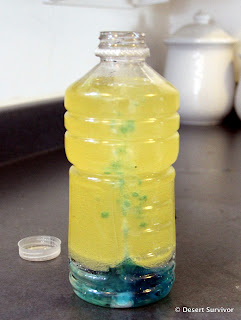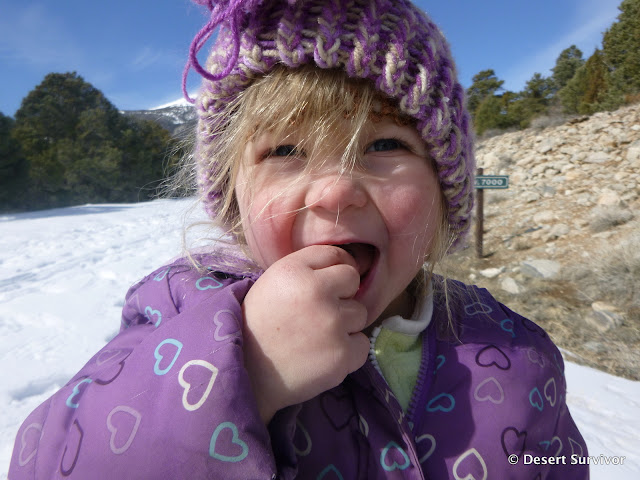The last week of February is the time to do the snow survey for the March 1st forecast. I was sort of looking forward to it, as the scenery is beautiful, but I was also sort of dreading it, as it's a really long day and I haven't been cross-country skiing since last winter.
We met at the road closure at 7 am, which meant for an earlier start and a more likely finish before sunset. Last year we ended by skiing in moonlight, and we didn't want a repeat of that.
The first mile and a half was along the road with two inches of snow, and often times less. It was a little frustrating not to be able to drive up the road, as the snow was so low. We were wondering if the whole day would be with so little snow. We saw lots of bare ground and signs of spring--many birds singing (mountain chickadees, Cassin's finches, dark-eyed juncos, common ravens, northern flickers, nuthatches, kinglets, and more). John told me that when he had skied up the day before, he had seen marmots at the marmot crossing sign. Wow, marmots in February! With the are south-facing slope bare of snow, they apparently can find some food.
We didn't see marmot tracks, but we did see lots of rabbit tracks and a fox that meandered back and forth across the road several times. When we saw the two tracks next to each other (above, rabbit on left, fox on right), I wondered how much time separated them.
We also found where a bunch of turkeys had crossed the road. They have spread all over the park, and this wouldn't be the only time we saw evidence of them.

We reached the first of the three snow survey sites after a little more than two hours. During the summer it's about a five to ten minute walk from the trailhead. The snow survey sites were established in 1942 by the predecessor of the Natural Resource Conservation Service (NRCS). These sites, part of a large network in the West, help the NRCS predict how much water will be in streams in the summer. Many of the snow survey sites have been automated, and the 10-mile round trip we were doing is one of the last, long courses left.
It only takes about 20-30 minutes to do the actual snow measuring at each snow course site. The basic procedure is to use a special metal tube to measure snow depth and then weigh the snow in it. This is done five times at preset distances from the snow course markers. The average is computed and compared to previous years. The first site had roughly 50 percent of average for the snow water equivalent (SWE), which is a nice way of saying how much water is in the snow. We hoped the upper two sites would be a little more positive.
Five of us started the snow survey, but one member turned back after the first site. He may have known what was to come:
Deep powder, sometimes up to our knees. It made trail blazing a real chore. We took turns leading, but none of us could go for very long because it was so taxing. People who love to ski powder must not spend much time going uphill in powder. And we had a lot of uphill to go--2,600 feet.
Here's a view I had at one point while I was leading--fresh snow with cool shadows. The scenery was beautiful, but it was hard to think about it sometimes, as we were gasping for air.
What was frustrating was that even though we were in deep powder, up higher on the hill all the snow had melt off. It was such a teaser!
We also had some obstacle skiing, like going over deadfall and under logs.
About lunch time we found a melted out spot and sat down for a few minutes. That 15 minutes was the only time during the ten hours that we got to sit. Mark couldn't get one ski off, and I couldn't get either off, due to the bindings freezing up. So we felt a little stuck. The temperature hovered near freezing, which meant that I got chilled relatively quickly and set off for Snow Course Site #2.
Snow Course #2 down in the trees and cold and snowy. After we finished that site, one member decided to head back and wait at the lunch spot. He was just a little too worn out due to the elevation and exertion. The remaining three of us headed on to the last site.
One thing that's good about getting way up there is that the views keep getting better. This area is so pristine, and I love the feeling of being out in the wild. Realizing that if any of us needed a rescue that we would have a very long wait makes it feel even more raw and makes me feel more alive. We carried a SPOT device and checked in regularly.
I kept on the lookout for winter beauty, like the snow melt circles around the aspen trees.
And a Douglas fir cone that had rolled down the slope, creating its own little trail.
The pure winter light made the limber pine needles stand out in the shadows.
Here comes Ben.
Then at about 9,500 feet, we saw some animal tracks. We had seen hardly any animal tracks above 8,000 feet, so we were surprised. What was out and about? It didn't take long to see the three-toed tracks and some wing brushes in the snow. A turkey had been up here. They are non-native, so we're none too pleased to see their evidence.
Finally, about 2 pm, we made it to the third snow course site at 9,600 feet. It's in a meadow longer than a football field.
Here I am, with my pack creating a strange silhouette.
Ben takes one of the snow samples, pushing the metal pipe through the snow until it reaches the ground. We found lots of mud under the snow.
Then the snow was weighed while I took notes. Both the second and third sites had roughly 70-75% of average SWE. We need more snow!
When we finished the fieldwork, it was time to head down the mountain. I fell several times, but the powder provided a soft landing. Getting back up was not easy, though. By the time we got back to the truck, I was thoroughly exhausted. Ten hours on skis does that to a person!
We have a photo in our house of my husband's grandfather helping with the snow survey decades ago. He and the group are all on snowshoes. I wonder how long it took them to do the snow surveys, and think of all the untold stories of these annual winter forays up the mountain in search of snow measurements.







































































